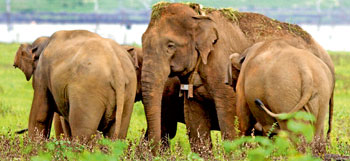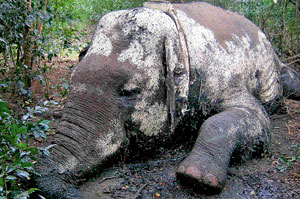While the human-elephant conflict (HEC) reaches tragic proportions, top conservationists have sought the urgent intervention of President Mahinda Rajapaksa to save a World Bank project, a main component of which was the effective management of the HEC.
Alerting the President over the loss of a “significant opportunity” to improve the country’s conservation effort through the Ecosystems Conservation and Management Project (ESCAMP) and encouraged by the recognition given by the Mahinda Chinthanaya towards conservation, in a letter sent recently, they have reiterated the need for the President to save the project which was to be implemented with an interest-free credit line of US$ 30 million from the World Bank.
 |
| The majestic ‘Loku Maama’ with other jumbos in the Kaudulla National Park |
We are supportive of sustainable development, they stress, pointing out, however, that “conservation is a vital pillar” in development. “Reconciling environmental conservation with socio-economic development will mutually support each other for long-term sustainability,” they emphasize.
“Our environment and its biodiversity also provide all citizens with valuable ecosystem services such as watershed protection and climate regulation while directly benefiting the economy through ecotourism and sustaining agriculture.”
Among the signatories are conservationists representing the Environmental Foundation Ltd., the Centre for Conservation and Research, the Wildlife and Nature Protection Society, the Leopard Trust and Ruk Rekaganno.
ESCAMP was a much-needed conservation project proposed by the Environment Ministry and agreed with the Finance Ministry as a part of the World Bank’s Country Assistance Strategy for Sri Lanka 2009-2012. It aimed to address some of the major issues facing the country, including the human-elephant conflict, loss of natural landscapes and the environmental services they provided, while promoting nature-based tourism in protected areas for revenue generation, the conservationists explain, adding, “We were heartened that the project utilized the input of the Technical Officers of the Forest and Wildlife Departments, rather than foreign consultants in the preparation.”
Explaining the process, the conservationists state that the ESCAMP preparation was guided by a Steering Committee chaired by the Environment Ministry and included representatives from the Department of National Planning (NPD) and Department of External Resources (ERD) of the Finance Ministry who were supportive of the project.
“The project design took approximately 18 months, and resulted in a comprehensive and useful proposal that would have truly benefited Sri Lanka’s environment. The Ministry of Environment shared the project proposal with NPD and ERD as early as August 2009, and at no point during this time did the Ministry of Finance object to the fundamentals of the project design. The conservation community was also consulted and kept up to date on the progress of the project, and many were pleased with its design and content,” they add.
As members of the conservation community consultative group that was associated with the project progress since mid-2009, we were recently informed at a meeting by the World Bank that several fundamental changes had been proposed by the Ministry of Finance during the final stages that completely altered the design and content of the project. These changes also completely altered the objectives of the project and because they could potentially cause considerable harm to the long-term sustainability of the protected areas, the World Bank took the unprecedented step of unilaterally withdrawing the proposal, they inform the President.
Meanwhile, the human-elephant conflict seems to be careening into an abyss of disaster with regular reports in the newspapers of the injury and hardship that villagers face as well as the vicissitudes of elephants.
Ali prashna hari darunui, laments Ven. Tambuttegama Rathana Thera of the Digana Shri Visudharama Vihara in Ehetuwewa (about six miles from Galgamuwa), explaining that he is even facing difficulty in getting the dana. He sees to the spiritual needs of about 300 families.
The temple doesn’t have lights, he says, and in the night he keeps a lit lampuwa, shining a tiny torch into the garden when he hears the elephants, to ward them off. Three weeks ago a mother of five children was charged and killed by an elephant when she went into the scrub jungle close to her home to tie up her cattle. Another person was trampled and injured. It was just three days ago that the children of the woman killed by the elephant called him around 9 a.m. and said, “Sadhu, Sadhu, watte ali innawa.” When he rushed to their humble home, there was an elephant near the coconut tree.
The monk stresses that ali prashna have increased in recent times, a view echoed by many villagers that the Sunday Times spoke to on the phone. The elephants rampage through the newly-sown kumburu (paddy fields), leaving a trail of destruction and forage among the jak and cashew trees, he says, adding that “ali, vee bonawa” (elephants drink paddy).
The elephants are getting chased from one village to the next. Sometimes there are about 20, at others 40 and sometimes even 70, says ven. Rathana Thera, pleading for electricity which has “come to the village but not to the temple”.
The tale of woe of R.M. Somaweera from Kaluwilapotana off the Kurunegala-Anuradhapura Road is similar. The elephants raid the kumburu and also the home gardens, he says, pointing out that they come from the 900-acre teak plantation across the road. The villagers, about 200 families, are house-bound after 7 p.m. as around 50 elephants take over the area. Five people have been killed by elephants in the past two years, says Somaweera, bringing to the fore not only the acceleration of the human-elephant conflict but also the need to manage and mitigate it.
The agony of the hunted jumbos
The humble people battered and bruised in the human-elephant conflict, at least can voice their opinion. What of the hapless elephants?
Tragically, not only are they splattered with bullets, the wounds of which fester with maggots spilling out of them leading to agonizing death, but as a consequence of “development”, elephants are also driven from their habitats through translocations and drives which have proven to be futile. Just a glance through the newspapers will reveal the raw deal that these creatures have been dished out.
It was a translocation that led to the death of the majestic Galgamuwa tusker. With five-foot tusks, it was believed to have had the longest tusks among Sri Lankan elephants in the wild. This tusker was being taken to a reserve after unproven allegations of killing people when the floor-boards of the lorry collapsed, causing fatal injuries to it.
The Sunday Times understands that subsequently the Department of Wildlife Conservation (DWC) decided to minimize translocations and drives. Dreadful as it was losing such an iconic animal, perhaps it was not in vain if that opens our eyes to the misery we pile upon these majestic animals in the name of development, a conservationist pointed out.
Another more recent elephant death at Kantale brings the conflict between elephants and development into sharper focus. ‘Loku Maama’ was one of the dominant breeding bulls at the famous ‘Gathering’ at Minneriya-Kaudulla. Many are those who have seen ‘Loku Maama’ up close near their safari-jeeps and marvelled at this huge pachyderm which was quite at ease with the hordes of visitors that throng the area annually.
‘Loku Maama’ was collared at Kaudulla on November 6, 2010, as part of an ongoing collaborative project between the Centre for Conservation and Research and the DWC to obtain information that can guide HEC mitigation. ‘Loku Maama’ roamed the Kaudulla area, visiting the herds, but with the onset of the rains he made his way to Kantale on January 24, this year. In the past few decades the vast Kantale paddy fields, abandoned due to the war, had turned into fertile grasslands where ‘Loku Maama’ and his cousins revelled. In his last foray there, however, he didn’t know a crucial change in dimension the area had taken.
Rapid but unplanned development following the end of the war had brought a new danger – the humans had come back. Not only were they laying claim to their former lands but they were also felling more forests and encroaching on state land without any plan or control, it is learnt.
‘Loku Maama’ who could not understand the transformation in the land he called home, was doomed. Felled by the fire from a cultivator’s gun, ‘Loku Maama’ breathed his last at 2.30 a.m. on February 19, closing another tragic chapter in the human-elephant conflict. |



